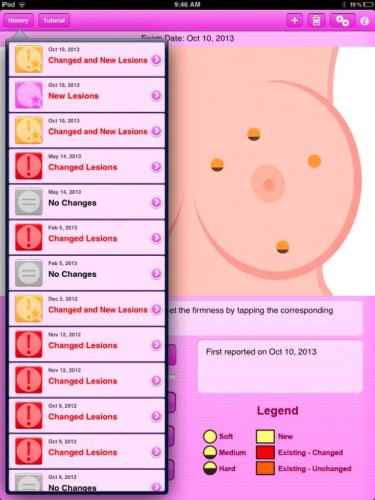A new application increases the reliability of breast self-examination for early detection of the disease

The famous actress Angelina Jolie surprised the whole world when she cut off both her breasts as a preventive measure against breast cancer. This extreme step was received with mixed feelings by women and doctors alike. Some justified the step and many women followed suit, but some saw this step as an excessive reaction and premature damage to femininity.
Angelina Jolie's move has a certain logic in view of the prevalence of the disease and the difficulty in early detection of breast cancer at a stage that allows effective treatment of the disease before it spreads. Indeed, in the USA, despite the high awareness of the importance of early detection and the availability of mammography, in 2012 226,870 women were diagnosed with generalized breast cancer, of which 11,000 were under the age of 40. That year, 39,510 women and approximately 400 men died of breast cancer.
Even in Israel, the data from the Center for Disease Control in the Ministry of Health indicate an increase in the cumulative risk of getting breast cancer, and it currently stands at one in 7.5 women. In 2009, 4,005 women in Israel were diagnosed with invasive breast cancer, meaning a tumor that breaks through the ducts into the breast tissue.
Mastectomy at a young age is obviously not the perfect answer to the fear of developing breast cancer, and moreover, it is not insurance against the development of the disease in other organs or against the development of another type of cancer. The routine tests for the early detection of breast cancer, such as mammography, magnetic resonance imaging (MRI) and ultrasound, are available and enable early detection of the disease and effective treatment in its initial stages. But none of these methods are able to detect all breast tumors in the early stages, so despite the constant refinement of these methods, there is a lot of concern among women in general and especially among women who carry the genes that increase their chances of contracting the disease.
A monthly manual examination of the breast has been recommended to women for decades as a means of early detection of breast cancer. In recent years, some cancer societies have withdrawn from the recommendation due to the fear that the self-examination is not reliable due to the woman's lack of sufficient knowledge of her breasts and her ability to distinguish between previous findings and new ones, as well as her inability to feel small tumors. The need to identify the tumor in very early stages, the problematic nature of manual self-examination when the woman is unable to compare the findings of a current examination with her healthy breast anatomy for all its lumps, and the recognition that an annual mammogram is insufficient and sometimes allows the tumor to grow for a year undisturbed, as well as the lack of routine examinations under the age of 40, all These caused one of us (Ziv Harish) to develop a new method for self-examination of the breast. The new method is an application that allows a woman to map the breast and the findings of the manual examination and compare the results of the current examination with the results of past examinations. The application allows graphic or photographic documentation of the breast and its findings. The application is equipped with a system that allows standardization of the breast image and compensates for changes in the angle of the image between tests. Upon discovering any change in the findings of any test compared to previous tests, the software warns the test subject and urges her to contact the attending physician. The app is currently only available in the Apple Store, and is sold at a nominal price of 99 cents.

We hope that the app will encourage women to check their breasts frequently, as with its help they will have more confidence in manual self-examination. They will know the topography of their breast and will be able to locate and document, and in fact map, any change in the breast and seek medical advice in the early stages of the disease.
The app can be downloaded here:
About the authors
Dr. Ziv Harish studied medicine at Ben-Gurion University, and specialized in pediatrics and allergy and immunology at the Albert Einstein School of Medicine in New York. Today he runs a private practice in Englewood, New Jersey.
Bracha Reger, Emeritus Professor of Microbiology and Immunology at the Faculty of Health Sciences at Ben Gurion University, President of Ort Israel and Chairman of the Academic Council of Ort Israel. Served as the chief scientist of the Ministry of Health and was a member of the Council for Higher Education.
